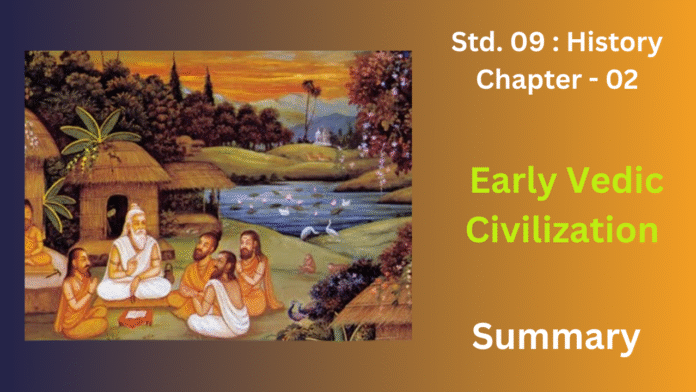The narrative commences by exploring scholarly discussions on the Aryans’ origins, often pointing to Central Asia, and their subsequent migration into the Indian subcontinent through northwest passes, settling initially in the fertile Sapta Sindhu region. The Rigveda, their oldest scripture, serves as the primary source, revealing insights into their daily lives, society, beliefs, and economy.
Early Vedic political structure was tribal, evolving from family units to tribes led by the Rajan, whose authority was influenced by tribal assemblies like the Sabha and Samiti. Society was patriarchal but relatively egalitarian, with fluid occupations and a nascent Varna system. Women held a more respected position, and cattle rearing was central to their economy, alongside developing agriculture and barter trade.
The early Aryans worshiped nature’s forces as deities like Indra and Agni, with rituals and hymns conducted on open-air altars. Temple construction and idol worship were absent. Their economy was primarily pastoral, gradually incorporating agriculture and essential crafts, with barter as the mode of exchange.
EXERCISES
Question 1.
Name any two early Aryan settlements.
Ans:
Based on the typical understanding of the Early Vedic period, the primary area of early Aryan settlement was the Sapta Sindhu region. This term refers to the land of the seven rivers.
Therefore, while “Sapta Sindhu” encompasses a broader area, you could consider specific river valleys within it as early settlements. Two prominent river systems within the Sapta Sindhu that were early Aryan settlement areas would be:
- The Indus River Valley: This was the core of the Sapta Sindhu region and the initial focus of Aryan settlement upon entering the subcontinent.
- The Saraswati River Valley: The Saraswati River (which later disappeared) was highly revered in the early Vedic period and was a significant area of settlement and cultural development for the early Aryans.
Question 2.
Name the first of the Vedas. Or Which is the oldest Vedic literature.
Ans:
The Rigveda is the first of the Vedas and the oldest Vedic literature.
Question 3.
What does the Rijj Veda contain ?
Ans:
The Rigveda, recognized as the oldest of the Vedas, is a collection of 1,028 hymns contained within ten books. These hymns are primarily dedicated to honoring key Vedic gods, such as Indra, Agni, Varuna, and Surya.
Content and Themes
Beyond its central focus on divine praise, the Rigveda contains a rich tapestry of content that provides insight into early Vedic society. It includes:
- Prayers for Well-being: The hymns often contain supplications and prayers for material wealth, good health, and success in battles.
- Philosophical Ideas: It offers early, foundational thoughts on creation and the origin of the cosmos, providing a glimpse into the philosophical inquiries of the time.
- Ritualistic Elements: The text contains elementary details related to rituals and sacrifices performed by the early Aryans.
- Societal Glimpses: The Rigveda provides a window into the structure of early Aryan society, including the initial conceptualization of the varna system, which divided society into four classes.
- Geographical Information: It offers clues about the settlements of the early Aryans, mentioning rivers and landscapes that help historians understand their geographical presence in the Indian subcontinent.
Question 4.
Mention any of the Vedic hymns that enables us reconstruct the Early Vedic Civilization.
Ans:
The diverse hymns within the Rigveda offer vital clues for understanding the Early Vedic Civilization. For example, the Purusha Sukta (Rigveda 10.90), while appearing later, provides an early symbolic narrative of the origin of the four varnas (social divisions) from a primordial being. This helps us grasp the initial social order, even in its less defined state. Hymns dedicated to Ushas (like Rigveda 1.48, 1.92) vividly depict the dawn, illustrating the natural environment and daily life, frequently mentioning farming and the value of cattle, thereby revealing their economic basis. Battle hymns addressed to Indra (such as Rigveda 1.32, narrating his fight with Vritra) not only celebrate Indra’s power but also illuminate the early Aryans’ conflicts, military capabilities, interactions with other groups, and the significance of warfare. Hymns referencing rivers (for instance, the Nadistuti Sukta in Rigveda 10.75) enumerate and praise various rivers, particularly within the Sapta Sindhu region, assisting in understanding their settlement patterns and the importance of rivers. Additionally, hymns concerning hospitality and social interactions (scattered throughout the Rigveda), emphasizing generosity and communal values, offer insights into their social morals and customs.
Question 5.
How can you say that the Rig Vedic Age was the Non Iron using phase of Vedic history ?
Ans:
The Rig Vedic period is generally considered a non-iron using phase primarily due to linguistic, archaeological, and contextual evidence.
Linguistic Analysis
The Rigveda uses the term “ayas” to refer to metal, but there is no distinct term for iron. Scholars interpret “ayas” to mean copper or bronze because its description and use align with the properties of those metals, which were known from the preceding Harappan civilization. Later Vedic texts, such as the Yajurveda and Atharvaveda, introduce new terms like “shyama ayas” (dark metal) or “krishna ayas” (black metal) which are widely accepted to denote iron.
Archaeological Evidence
Iron use becomes more common in later archaeological layers, particularly those linked with the Painted Grey Ware (PGW) culture, which corresponds to the later Vedic period (c. 1000 BCE onwards). This suggests that iron technology was not a significant part of the early Vedic material culture.
Contextual Clues
These metals were suitable for casting and hammering. There is no mention of the unique strength and cutting ability that iron would have provided, which would likely have been a noteworthy technological advancement. This lack of emphasis on iron’s specific characteristics further supports the conclusion that it was not in widespread use during this period.
Question 6.
Name any two of the four Varnas.
Ans:
The names of any two of the four varnas are:
- Brahmana
- Kshatriya
Question 7.
What was the position of women in the Rig Vedic age ?
Ans:
During the Rig Vedic age (approximately 1500-1000 BCE), women held a more respected and significant position in society compared to later Vedic periods. They enjoyed a degree of equality with men in several aspects of life.
Women had access to education and could study the Vedas and other sacred texts. There were even women rishikas (female seers or poets) who composed hymns in the Rigveda, such as Lopamudra, Ghosha, Apala, and Vishwavara. They could participate in religious ceremonies and sacrifices alongside their husbands. In the social sphere, women could attend assemblies (Sabha and Vidatha) and engage in discussions. The practice of Swayamvara allowed women to choose their own husbands in some instances, indicating a degree of autonomy in marriage. Furthermore, child marriage and the Sati system were absent during this era, and widow remarriage was also practiced.
While the society was patriarchal and the birth of a son was generally preferred, daughters were not neglected and received education. Women held a respectable position within the household and were considered “Ardhangini” (better half) and “Sahadharmini” (equal partner) in religious and social duties.
Question 8.
What were the two main occupations of the Rig Vedic Aryans?
Ans:
- Pastoralism (Cattle Rearing): This was the most significant occupation, especially in the early Rig Vedic period. Cattle, particularly cows, were considered the primary form of wealth. The term “Gomat” was used for a wealthy person, literally meaning “one who owns cows.” Wars were often fought over cattle, and terms like “Gavishti” meant “search for cows” and also “war.”
- Agriculture: While pastoralism was dominant initially, agriculture gradually became an important occupation. The Rigveda mentions terms related to cultivation like sowing, harvesting, and threshing. Barley (yava) was a principal crop, and other grains were also cultivated. The plough (langala) pulled by oxen was used for farming.
Question 9.
What form of worship did the Aryans follow during the early Vedic period?
Ans:
The provided text outlines the religious practices of the early Vedic Aryans, focusing on their worship of natural forces and the absence of temples or idol worship.
Deities and Worship
During the early Vedic period, Aryans revered natural elements as gods and goddesses. They believed these gods controlled natural events and human destinies. Their primary form of worship involved reciting hymns from the Rigveda to praise and invoke the deities for blessings like good health, prosperity, and success in war.
Rituals and Practices
Worship was conducted in open-air settings, as the concept of temples and idol worship had not yet developed. The central ritual was the yajna, a fire sacrifice where offerings such as ghee, milk, grains, and sometimes animals were given. These practices highlight a direct and personal connection with nature, which was the core of their religious beliefs.
Question 10.
Name the two political institutions which exercised check on the powers of the King in the Rig Vedic period.
Ans:
During the Rig Vedic period, the authority of the Rajan (tribal chief) was subject to oversight by two key political bodies:
The Sabha, a more exclusive council of elders, likely composed of influential tribal members and wise individuals, served as an advisory body to the Rajan. It held the potential to express disagreement and shape his decisions on important matters. This assembly is generally viewed as possessing a more select and impactful membership.
The Samiti, a wider assembly encompassing the general populace or the entire tribe, offered a forum for discussion and could exert a broader form of popular oversight or approval regarding the Rajan‘s actions. While the precise extent of its powers remains a subject of scholarly debate, it likely held the capacity to elect or even reappoint the Rajan in certain instances and could articulate the collective will of the tribe on significant issues.
Question 11.
Mention the important features of the religion of the early Vedic period.
Ans:
The religious beliefs and practices of the early Vedic period were characterized by a focus on natural deities, simple rituals, and a core concept of cosmic order.
Key Characteristics of Early Vedic Religion
- Deification of Nature: Early Vedic people revered powerful natural forces, personifying them as gods. Indra (storms), Agni (fire), Surya (sun), and Varuna (water) were among the most important deities.
- Vedic Hymns and Rituals: The Rigveda, a collection of hymns, served as their primary religious text. These hymns were prayers and praises offered to the gods during yajnas (sacrifices). In these rituals, offerings of ghee, milk, and grains were made, with Agni acting as a messenger between humans and the divine.
- Absence of Temples and Idols: Religious observances were simple and direct. The focus was on direct communication with the gods through prayers and offerings, without the use of elaborate temples or idol worship.
- Cosmic Order (Rita): A central concept was rita, which represented the fundamental moral and cosmic order of the universe. Deities like Varuna were considered the guardians of this order, highlighting the importance of righteousness and universal balance.
Question 12.
State the importance of Sacrifices in the early Vedic ritual.
Ans:
Sacrifices (yajnas) held profound significance in early Vedic rituals for several key reasons:
- Serving as a Conduit to the Divine: They were viewed as the principal means of communication with the gods. Agni, the fire deity, acted as the essential intermediary, transporting offerings and prayers from the human sphere to the divine realm through smoke and flames.
- Soliciting Divine Grace: The Aryans conducted sacrifices to appease the deities and seek their blessings for various life aspects, including health, longevity, prosperity, abundant livestock, successful harvests, victory in conflicts, and protection from adversities.
- Upholding Cosmic Harmony (Rita): Sacrifices were also believed to contribute to the maintenance of the cosmic order (rita). By correctly performing rituals and offering appropriate oblations, the Aryans believed they were supporting the balance and harmony of the universe, as established by deities like Varuna.
- Fulfilling Religious Duties: Performing sacrifices was considered a sacred obligation and a way to reciprocate for the blessings and sustenance received from the divine powers.
- Fostering Social Cohesion: Large-scale sacrifices often involved the entire community or prominent tribal members, serving as social gatherings that strengthened communal bonds and emphasized the importance of religious practices in their collective life. The distribution of leftover offerings could also have had social and economic implications.
- Establishing a Tangible Link with the Divine: Sacrifices provided a concrete way for humans to interact with the abstract concept of the divine.
Question 13.
Mention the important changes that took place in their religion of the later Vedic period.
Ans:
The religion of the Later Vedic period underwent notable changes from its earlier form. Rituals and sacrifices became far more elaborate and complex, shifting the focus from direct communion to meticulously performed ceremonies. This complexity led to the increased power and influence of the Brahmin priestly class, who became essential for conducting these intricate rites. Towards the end of this period, abstract philosophical ideas began to emerge in the Upanishads, exploring concepts like Brahman and Atman and emphasizing knowledge over ritual. Religious practices also became more symbolic, with deeper interpretations of hymns and rituals. Additionally, some deities started to be associated with specific social classes (varnas).
Sturctue Questions.
Question 1.
Discuss the sources to reconstruct the Early Vedic (Rig Vedic) Past with reference to the following:
(a) Indra, the most favorite God of the Aryans
(b) Agni, the personification of Sacrificial fire.
(c) References to the Cow in the Rig Vedic hymns
Ans:
Reconstructing the Early Vedic (Rig Vedic) past significantly depends on the Rigveda.
(a) Indra’s Prominence: Numerous hymns dedicated to Indra portray him as a powerful warrior, Vritra’s destroyer (symbolizing chaos), and the rain-bringer. These reveal his central cosmological role, their reliance on rainfall for agriculture (secondary to pastoralism), and their martial valor. His epithets and heroic narratives highlight Aryan values of strength, courage, and their understanding of cosmic order.
(b) Agni’s Sacrificial Role: Agni, the second most invoked deity, is depicted as the divine priest and messenger between humans and gods, embodying sacrificial fire. Hymns detail fire’s ritual importance, underscoring sacrifices’ central role in their religious practices and their belief in Agni’s power to convey offerings to other deities.
(c) Cow’s Significance: Frequent mentions of the cow emphasize its immense economic and social importance. Terms like “Gomat” (wealthy) and “Go” in various contexts illustrate its central role as a unit of value in their pastoral economy. Battles over cattle (“Gavishti”) further highlight its importance and tribal conflicts, suggesting early reverence for the animal.
Question 2.
Describe the social life of the Rig Vedic Aryans with reference to the following:
(a) The Family Structure
(b) Position of Women
(c) Varna System
Ans:
The social organization of the Rig Vedic Aryans, rooted in kinship, presented a relatively equitable structure that would undergo later transformations.
(a) Family Structure: The kula, or family, formed the bedrock of society, structured along patriarchal lines. The family was pivotal in social, economic, and religious spheres, with rituals frequently conducted within its framework. While the birth of sons was particularly valued for lineage continuation and their roles in warfare and agriculture, daughters were not necessarily unwelcome and received some education.
(b) Position of Women: In contrast to later periods, women in the Rig Vedic era enjoyed a more esteemed position. They had access to learning and could study Vedic texts. Certain women even achieved the status of rishikas (female seers) and composed hymns within the Rigveda. The practice of Swayamvara allowed women to choose their spouses in certain instances. Although society was patriarchal, women held a significant and respected place within the family and community, often referred to as Ardhangini (half the body) of their husbands, signifying their partnership.
(c) Varna System: The varna system was in its nascent stages during the Rig Vedic period and had not yet solidified into the rigid, hereditary caste system of later times. The Rigveda mentions four varnas: Brahmana (priests), Kshatriya (warriors), Vaishya (commoners, including merchants and farmers), and Shudra (servants). However, the distinctions between these groups were likely more fluid and based on occupation rather than birth. Social mobility between varnas appears to have been possible. The Purusha Sukta hymn in the later part of the Rigveda offers a symbolic origin of the varnas, but its interpretation as establishing a strict hereditary system for the early Rig Vedic period is debated. Occupational divisions existed but were not yet fixed by birth, and the social hierarchy was less pronounced.
Question 3.
With reference to the following explain the main features of the Rig Vedic Economy:
(a) Agriculture
(b) Domestication of Animals
(c) Trade Transactions, Crafts and Transportation
Ans:
The Vedic period’s economy underwent a significant transformation, evolving from a pastoral-based system to one centered on agriculture, while also incorporating the high value of livestock and the development of early trade and crafts.
Agricultural Shift
The Vedic people gradually transitioned from being a nomadic, pastoral society to a settled, agrarian one. Their farming practices were relatively simple, relying on ox-drawn plows and natural rainfall to cultivate crops, with barley (yava) being the most significant crop.
The Role of Livestock
Livestock was the cornerstone of the Vedic economy, with cattle holding the highest value. Cows were a symbol of wealth and a source of food, while oxen were essential for agricultural tasks and transportation. The economic importance of cattle is reflected in their use as a form of currency in transactions and their frequent mention in religious texts. Horses were also highly valued, primarily for their military and racing applications.
Trade and Crafts
Artisans were skilled in various crafts, including carpentry for creating chariots and homes, and metalworking using ayas (copper or bronze) to produce tools and weapons. Weaving was another prominent craft. Transportation was primarily land-based, using horse-drawn chariots and ox-drawn carts for localized trade.


